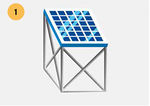Knowledge fuels change
For over a decade, Energypedia has shared free, reliable energy expertise with the world.
We’re now facing a serious funding gap.
Help keep this platform alive — your donation, big or small, truly matters!
Thank you for your support
Difference between revisions of "SPIS Toolbox - Mounting Structure"
***** (***** | *****) m |
***** (***** | *****) m |
||
| Line 1: | Line 1: | ||
| − | + | {{SPIS Banner}}{{Back to Get Informed}} | |
| − | {{SPIS Banner}} | ||
| − | |||
== '''<span style="color:#879637">Mounting Structure</span>'''<br/> == | == '''<span style="color:#879637">Mounting Structure</span>'''<br/> == | ||
Revision as of 12:05, 9 June 2017

Introduction
Do want to know all about SPIS – Solar Powered Irrigation System : Please go to the newly launched standalone Solar Powered Irrigation Systems (SPIS) website (www.spis-toolbox.org) , featuring three SPIS toolbox:
- Toolbox for beginners,
- Toolbox for farmers (new SPIS Web based App – to calculate design of the pumps),
- the Toolbox for experts - the updated version - Version 6
and additional resources (Publication about SPIS).
The Toolbox on Solar Powered Irrigation Systems (SPIS) is designed to enable advisors, service providers and practitioners in the field of solar irrigation to provide broad hands-on guidance to end-users, policy-makers and financiers. Risks related to system efficiency, financial viability and the unsustainable use of water resources can thus be minimized. The Toolbox comprises informative modules supplemented with user-friendly software tools (calculations sheets, checklists, guidelines). read more
Modules and tools touch upon:
- assessing the water requirements,
- comparing the financial viability,
- determining farm profitability and payback of investment in SPIS,
- sustainably design and maintain a SPIS,
- highlight critical workmanship quality aspects,
- and many more.

style="width: 160px; background-color: rgb(111, 142, 43);" | ►Back to the Module Page
Mounting Structure
In addition to the irradiance and cell temperature, the output of a solar panel is also dependent on the orientation and tilt angle of the panel surface. To maximize the output, a site-specific optimal orientation has to be found.
Mounting options:
There are basically two alternatives to mount solar panels on a metal structure:
- installation with a fixed tilt angle;
- installation on a solar tracker with varying orientation.
The fixed installation of solar panels on a rigid structure is the cheapest, most reliable and most common method. Metal supports that are pile-driven into the ground are generally recommended for larger systems. They make the utilization of concrete foundations redundant and save labor and material cost. However, in developing countries, simple concrete foundations are often used for smaller installations and represent an appropriate solution, provided that static requirements are met. The installation is typically oriented north or south to have a relatively good distribution of the output over the course of the day.
Installations oriented in east and west directions are relatively new. However, it requires more panels to get a stable output over the day. But with falling panel prices, this might be an interesting alternative for remote areas.
When the orientation of the mounting structure is variable over one or two axes,this is referred to as a solar tracker (see figure on the next page).
Solar tracking has two advantages:
- gain in additional solar radiation – the amount of solar radiation received by the solar panels increases between 25–35% (annual mean value), depending on solar tracker type and installation site.
- even distribution of solar irradiance throughout the day – the generated electricity and thus the pump’s water flow is almost constant over the day. This is important in an SPIS configuration where the water is pumped directly to the field without passing through a reservoir.
Disadvantages of solar tracking:
- solar tracking is costly and substantially increases the overall system cost;
- the mechanical parts and the electrical motor of the tracking system require regular maintenance and spare parts.
This has to be kept in mind in particular for installations that are planned for remote areas or areas with limited technical services.
For both mounting options it is important to avoid galvanic corrosion when connecting metal structures. This can be done by selecting materials with similar corrosion potentials or by breaking the electrical connection by insulating the two metals from each other.
Mounting structure and theft
The type and the quality of the mounting structure are also a determining factor with regard to the risk of theft of the PV panels. With the increased application of photovoltaic installations for electricity generation the risk of theft is increasing. Common theft-prevention measures include:
- use of lock tie nuts;
- spraying the owner’s ID with non-removable spray paint onto the back of the panels;
- integrating the solar panels into the mounting structure (non-detachable);
- placing the mounting structure out of easy reach by using elevated structures, fences or floating PV systems.
Solar systems:
- fixed installation
- one axis tracker, azimuth
- two axis tracker azimuth and inclination
- horizontal one axis tracker, south/north axis
- one axis tracker, south + north axis incline.






















